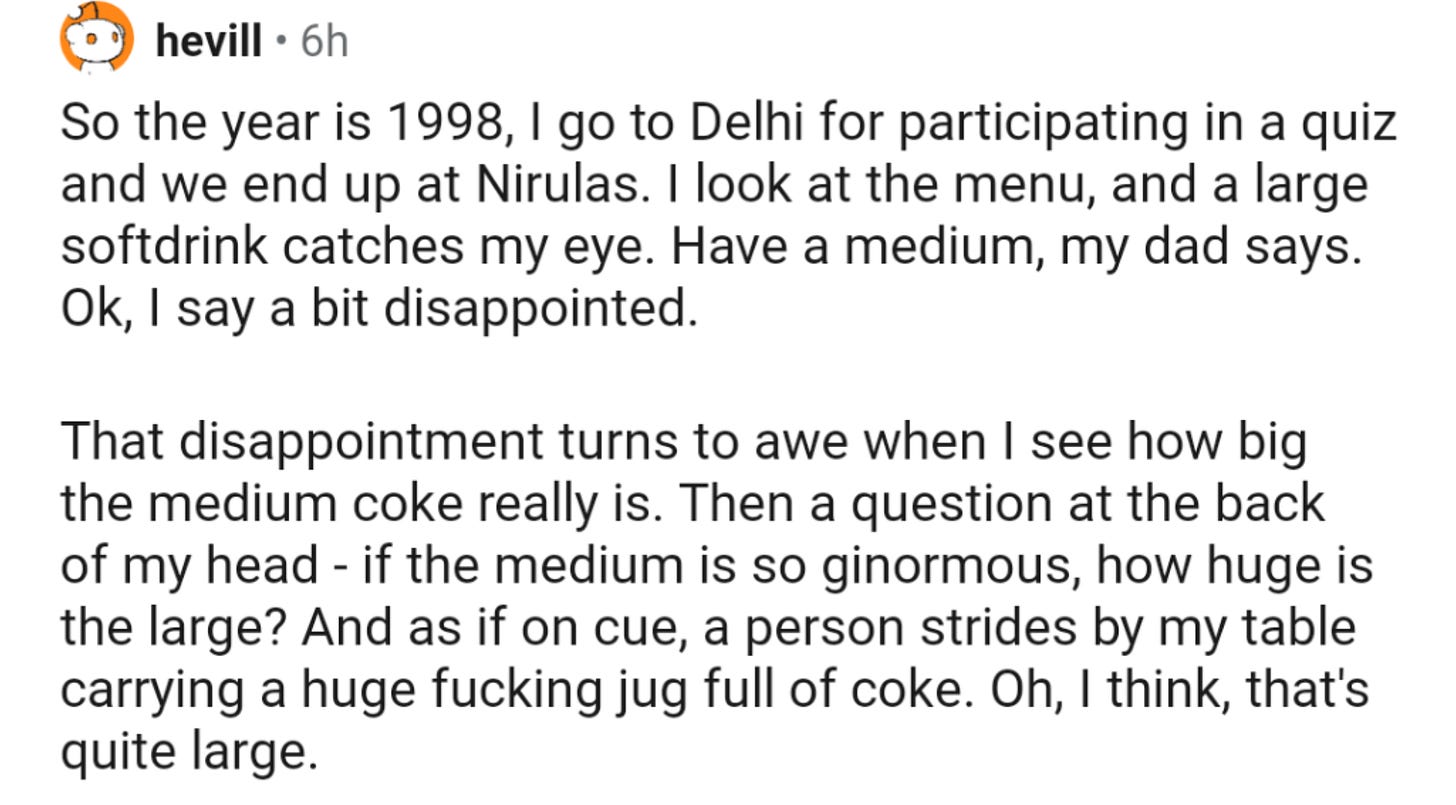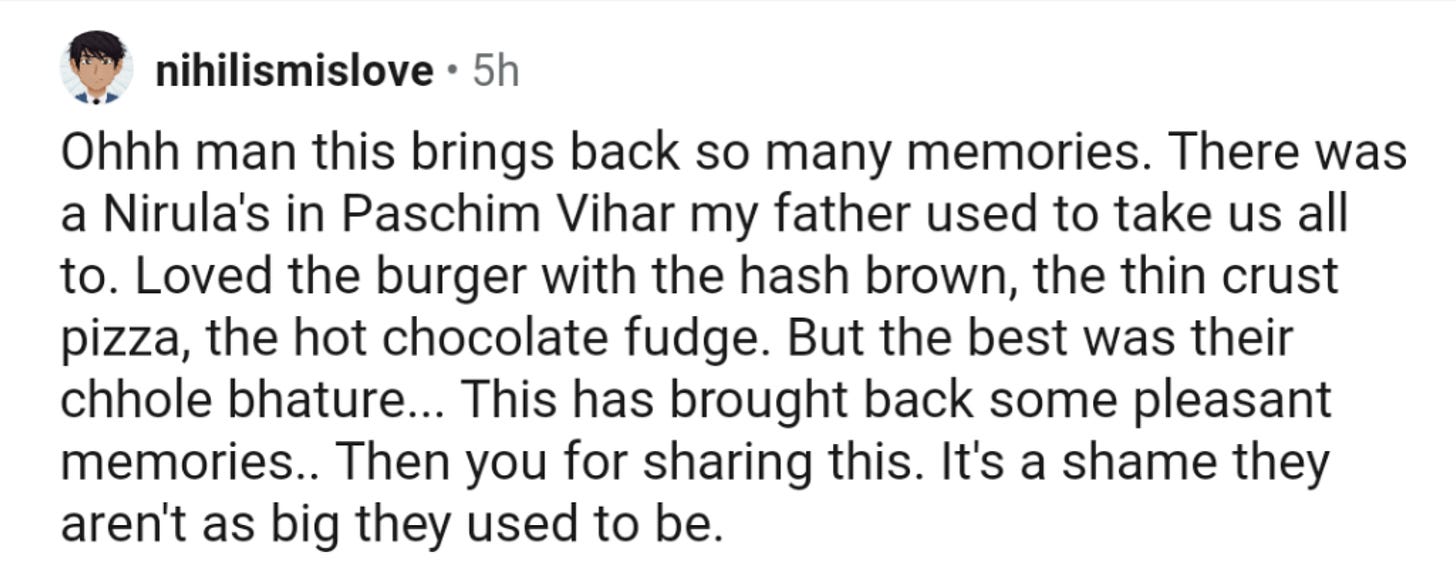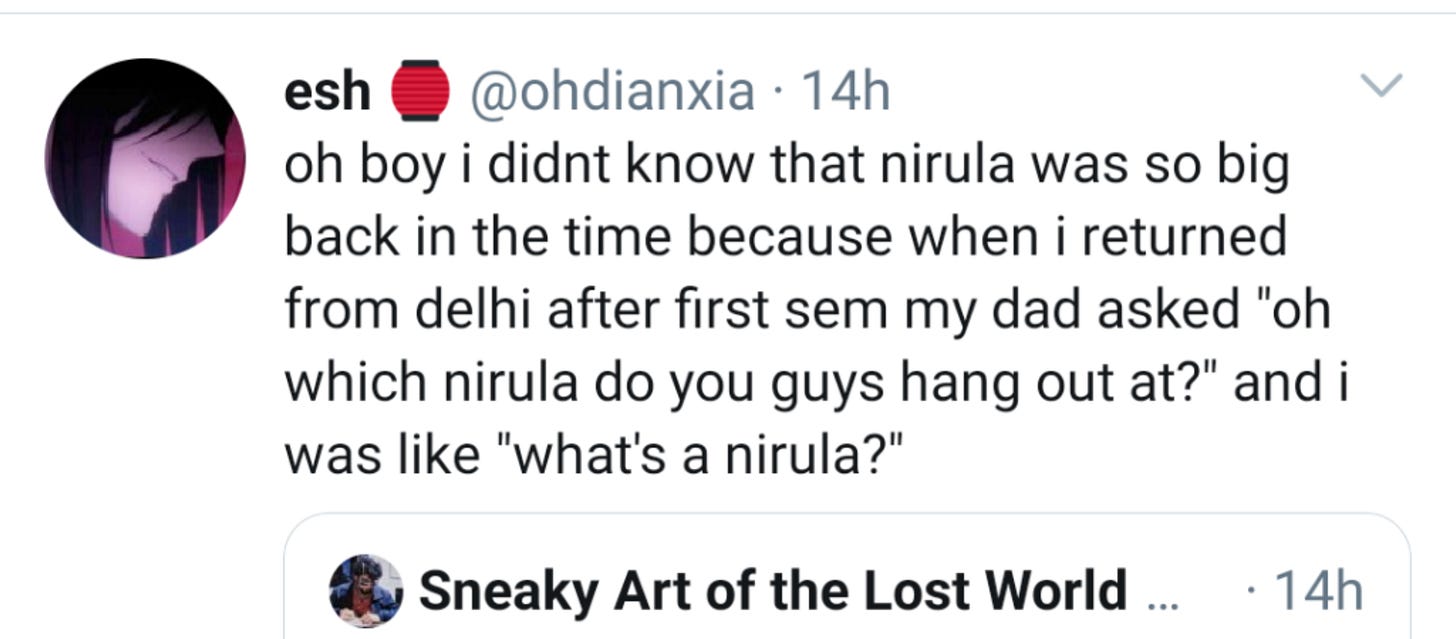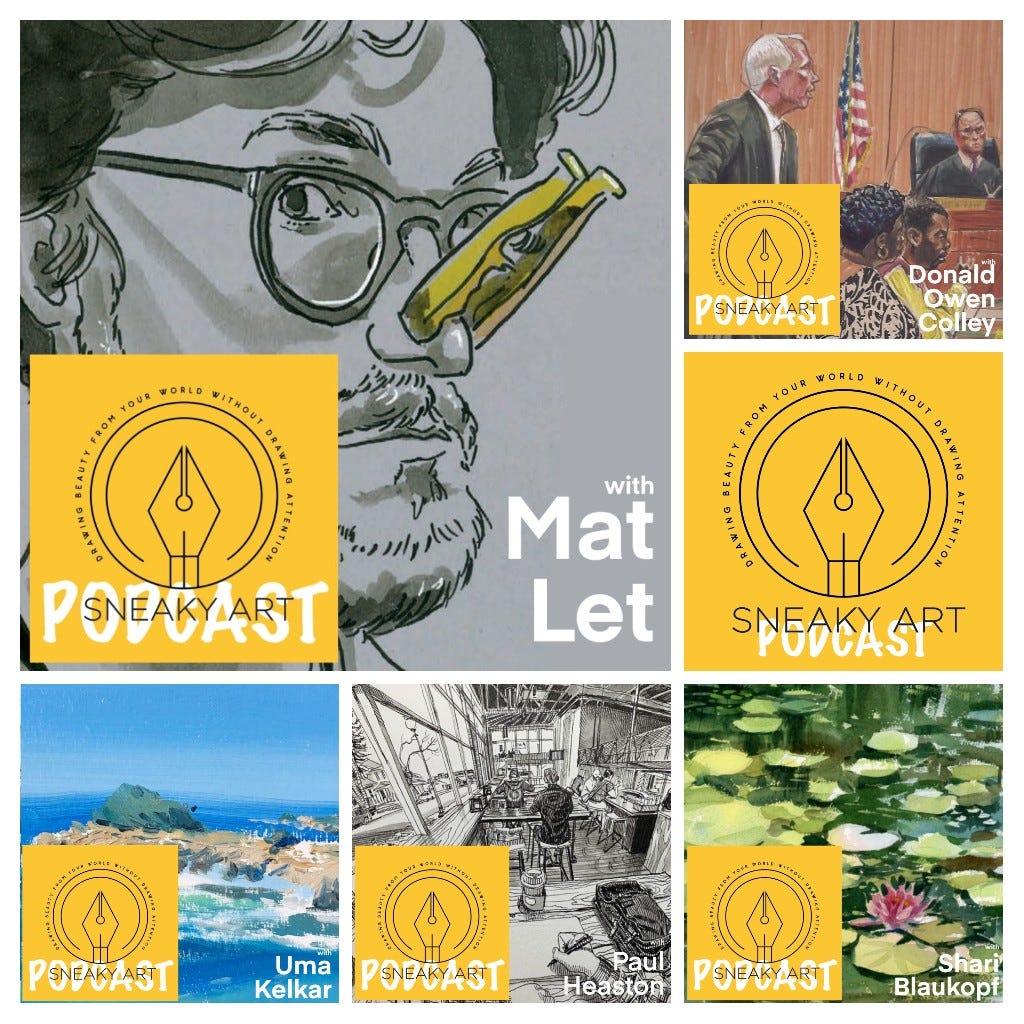#17 - Memories of Ice-Cream
There are a few things that I really appreciate about our hyper-connected times. In this issue, I share one such thing. Also, a summary of 5 wonderful conversations on the SneakyArt Podcast. Also, some ideas about group-think.
Nirula’s
I’m drawing a set of cityscapes for a client in NYC. They want to feature their favorite memories from different parts of India. The first drawing I made was of Kolkata, featuring some iconic locations on Park Street (Issue #14). Last week, I drew the second. It recreates a cherished childhood memory - going to Nirula’s in Connaught Place (New Delhi). Each piece is drawn with a fountain pen on 8x10” artboard, ready for framing.

I shared this image on my social media with the question -
“What is your favorite Nirula’s memory?”
I received some wonderful answers, and was re-shared by the Nirula’s IG page. They reached out to say thanks, and I was just thinking about how this is an incredible achievement of humankind. Within a day of me drawing something in Chicago, it can be noticed by the unwitting subjects all the way on the other side of the world. A drawing can generate nostalgia in hundreds of different minds all over the world, triggering dormant memories of tastes and smells, sending currents along neural circuits long-forgotten. And for a moment you are lost, away from your world, floating in a space and time that exists inside your mind, a world created by your memories and your nostalgia.
Just a drawing can do that. A little thing of ink and lines. Isn’t that crazy?
Some responses below…
Do you have a favorite Nirula’s memory?
I would love to hear it!
Smell and taste are deep repositories of long memories. Both are finely tuned senses, thanks to millions of years of evolution. We should be more thankful to our pre-historic ancestors for this. But quite literally no one even remembers them.
A memory can lie dormant inside the vault of our mind, so quiet you’d forgotten it was there. But an old taste, or a smell, even a hint of one or the other, and suddenly it is awake, as fresh as yesterday. It is a moment of great joy for me to chance upon such a memory, because I know that any such memory is uncorrupted by my over-thinking conscious mind.
Below, a timelapse video of this drawing.
More on the volatility of memory (even good memory) here. On the Hidden Brain podcast, host Shankar Vedantam speaks with researchers who discuss the fallibility of memory in our personal recollections and its wider implications in the justice system.
Decisions, Votes & Groups
What better time than an election to ponder over some concepts of group-think? Here are my thoughts around three popular phrases.
Never underestimate the power of stupid people in groups. What a ‘stupid person’ can achieve on their own is easily surpassed by their accomplishments within a group of their peers. The idea is that a group forms an effective shield which rebuffs any attempts to reason, leaving its members immune to late wisdom or second thoughts. Group enthusiasm essentially drowns any individual voice of reason. I don’t like this way to think about election results because it assumes a clear divide between stupid and non-stupid people, where the intelligent beings are tragically defeated by the greater numbers of the foolish. It is an argument that leans towards elitism, feudalism, and offers a convenient escape from deeper thought. I don’t like convenient answers. It also ignores some aspects of group-think which I think are worth considering.
The second phrase - ‘wisdom of the crowd’. It manifests broadly in platforms like Quora, Wikipedia or Yahoo Answers. But in other respects too, the power of ignorant people (within context) in a group can be leveraged to reach complex solutions that would otherwise be very difficult. A popular example - Imagine you have to guess the number of grains of rice in a jar. It’s not impossible to calculate, but at the individual level it is a high-intelligence task. What if you could arrive at a “close enough” answer with little cognitive effort? What if you asked a room-ful of people to make their best guesses? Some people would be way off in one direction, and a few in the other direction. But most answers would gravitate towards a number quite close to the truth. It’s a technique used in scientific inquiry in various ways. Even in basic signal processing, averaging multiple signal recordings can cancel out the effect of random noise. By this rationale, any fair election result (with decent turnout) is an accurate reflection of the values of that country, warts and all. Point to note, the elimination of random noise (poorly made individual decisions) does not eliminate systemic noise (gerrymandering, voter suppression, misinformation campaigns etc). A lot of people confuse the two, by accident or malicious intent.
The third concept is about individual values vs group obligations. From my academic life, a popular refrain around long meetings was - The collective IQ of a group is less than the sum of its parts. In essence, the decisions of a group do not demonstrate the cumulative intelligence of its members, but rather the different levels of intellectual compromise made by each person. Imagine yourself in a small social bubble. You expect everyone to respect the bounds of the social bubble. But one weekend you see a new face. Perhaps it is a guest or family member visiting someone in the group. And just like that, the bubble is burst. What do you do? Theoretically, you should leave immediately. But could you bring yourself to do that? You don’t want to create a scene. You don’t want to lose your bubble. And everyone else seems comfortable. You don’t want to be the only one putting their foot down. Maybe it is not so bad? With every passing moment, the original decision of “leaving immediately” is compromised.
The phrase we pick for any given situation - such as election results - is often the one most convenient to our worldview. This choice then shapes all of our future understanding of the complex beast known as democracy. All further judgments are shaped/influenced/biased/corrupted by the preceding judgments. Subconscious bias builds upon subconscious bias.
You can be perfectly intelligent and still make (outwardly) shocking compromises. Listen to this fascinating Hidden Brain episode about decisions taken “in the heat of the moment” and how they sometimes differ from our stated ideals or beliefs.
SneakyArt Podcast
We are now 5 conversations into the podcast, and it feels like a good time to appreciate some moments from these fascinating talks. In case you’re not caught up, here are some good reasons to listen.
Find the podcast on Spotify, Apple, or wherever you listen to podcasts. For listeners in India, it is now also listed on JioSaavn.
In Ep 1, I introduce the podcast and share the virtues of drawing on location. I explain my intention with these conversations.
In my first conversation, Ep 2 Drawing Lines with Paul Heaston, the artist talks about his early education in fine arts and oil painting. We discuss the interesting circumstances around his decision to switch to urban-sketching (USk) inside a little sketchbook.
In Ep3 Seeing in Color with Shari Blaukopf, I speak to the watercolorist and art-educator about seeing colors before lines. Shari talks about how regular blogging inspires her near-daily practice routine of the last 11 years.
In Ep 4 Painting Like an Engineer with Uma Kelkar, I speak with Uma Kelkar about how practicing art makes her a better person and a better engineer. She reflects on the ways she uses her creative pursuits to inspire her work as a researcher in Silicon Valley, and the popular misconceptions about artistic pursuit in tech-obsessed circles.
In Ep 5 Revealing Character with Don Colley, I speak to the Chicago-based artist about the decades of sketchbook art he has made, and the things he says inside those pages. I ask him about the ways in which he finds character and beauty in his urban surroundings, while not shying away from the ugly aspects of our world.
In Ep 6 Surviving Lockdown with Mat Let, I speak to the Parisian artist and travel-sketcher about how he is adapting to the COVID-era, and the release of his new book of lockdown sketches. This episode was coincidentally released the very day the second lockdown was announced.
Thank you for your attention. In the next issue, I present the new podcast episode + a SneakyArt retrospective of one of my favorite places in this great city, the Art Institute of Chicago.
Links
[Podcast] Hidden Brain episode on how memory can be deceiving
[Podcast] Hidden Brain episode about decisions taken in the heat of the moment.
[Instagram] SneakyArt
[Store] Commission a drawing
[SneakyArt Podcast] Read transcripts, links and shownotes.
[Timelapse] Nirula’s at CP, New Delhi
[Wiki] Wisdom of the Crowd








